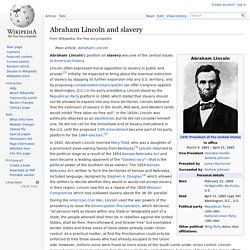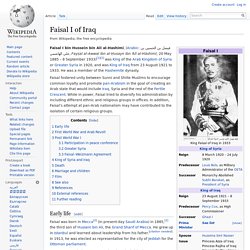

Abraham Lincoln and slavery. Abraham Lincoln's position on slavery was one of the central issues in American history.

Lincoln often expressed moral opposition to slavery in public and private.[1] Initially, he expected to bring about the eventual extinction of slavery by stopping its further expansion into any U.S. territory, and by proposing compensated emancipation (an offer Congress applied to Washington, D.C.) in his early presidency. Lincoln stood by the Republican Party platform in 1860, which stated that slavery should not be allowed to expand into any more territories. Lincoln believed that the extension of slavery in the South, Mid-west, and Western lands would inhibit "free labor on free soil".
In the 1850s, Lincoln was politically attacked as an abolitionist, but he did not consider himself one; he did not call for the immediate end of slavery everywhere in the U.S. until the proposed 13th Amendment became part of his party platform for the 1864 election.[2] Gustave Doré. Paul Gustave Louis Christophe Doré (/dɔːˈreɪ/; French: [ɡystav dɔʁe]; 6 January 1832 – 23 January 1883) was a French artist, printmaker, illustrator and sculptor.

Doré worked primarily with wood engraving. Biography[edit] «Le Christ quittant le prétoire» Doré was born in Strasbourg on 6 January 1832. By age five, he was a prodigy troublemaker, playing pranks that were mature beyond his years. Les Oceanides Les Naiades de la mer, 1860s In 1853, Doré was asked to illustrate the works of Lord Byron.[2] This commission was followed by additional work for British publishers, including a new illustrated English Bible.
In the 1860s he illustrated a French edition of Cervantes's Don Quixote, and his depictions of the knight and his squire, Sancho Panza, have become so famous that they have influenced subsequent readers, artists, and stage and film directors' ideas of the physical "look" of the two characters. Auguste Rodin. François-Auguste-René Rodin (12 November 1840 – 17 November 1917), known as Auguste Rodin (/oʊˈɡuːst roʊˈdæn/ oh-GOOST roh-DAN; French: [oɡyst ʁɔdɛ̃]), was a French sculptor.

Although Rodin is generally considered the progenitor of modern sculpture,[1] he did not set out to rebel against the past. He was schooled traditionally, took a craftsman-like approach to his work, and desired academic recognition,[2] although he was never accepted into Paris's foremost school of art. Sculpturally, Rodin possessed a unique ability to model a complex, turbulent, deeply pocketed surface in clay. Many of his most notable sculptures were roundly criticized during his lifetime. They clashed with the predominant figure sculpture tradition, in which works were decorative, formulaic, or highly thematic. Biography[edit] Formative years[edit] Rodin was born in 1840 into a working-class family in Paris, the second child of Marie Cheffer and Jean-Baptiste Rodin, who was a police department clerk. Faisal I of Iraq. Faisal I bin Hussein bin Ali al-Hashimi, (Arabic: فيصل بن الحسين بن علي الهاشمي, Fayṣal al-Awwal ibn al-Ḥusayn ibn ‘Alī al-Hāshimī; 20 May 1885 – 8 September 1933)[1][2] was King of the Arab Kingdom of Syria or Greater Syria in 1920, and was King of Iraq from 23 August 1921 to 1933.

He was a member of the Hashemite dynasty. Faisal fostered unity between Sunni and Shiite Muslims to encourage common loyalty and promote pan-Arabism in the goal of creating an Arab state that would include Iraq, Syria and the rest of the Fertile Crescent. While in power, Faisal tried to diversify his administration by including different ethnic and religious groups in offices. In addition, Faisal’s attempt at pan-Arab nationalism may have contributed to the isolation of certain religious groups.
Early life[edit] Faisal was born in Mecca[2] (in present-day Saudi Arabia) in 1885,[2] the third son of Hussein bin Ali, the Grand Sharif of Mecca. First World War and Arab Revolt[edit]
Crime.